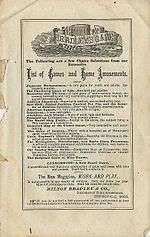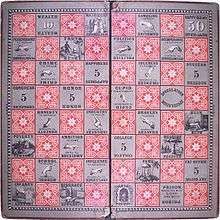Milton Bradley
| Milton Bradley | |
|---|---|
 | |
| Born |
November 8, 1836 Vienna, Maine, U.S. |
| Died |
May 30, 1911 (aged 74) Springfield, Massachusetts, U.S. |
| Occupation |
Entrepreneur Boardgame manufacturer |
Milton Bradley (November 8, 1836 – May 30, 1911) was an American business magnate, game pioneer and publisher, credited by many with launching the board game industry, with the Milton Bradley Company.
Biography
Born in Vienna, Maine in 1836, to Lewis and Fannie (Lyford) Bradley,[1] Bradley grew up in a working-class household in Lowell, Massachusetts after the family moved there in 1847.[2] After completing high school in 1854 he found work as a draftsman and patent agent before enrolling at the Lawrence Scientific School in Cambridge, Massachusetts. He was unable to finish his studies after moving with his family to Hartford, Connecticut, where he could not find gainful employment.[2] In 1856, he left home and got a job in the locomotive works of the Blanchard & Kimball (later Bemis & Company) in Springfield, Massachusetts.
After the company was shuttered during the recession of 1858, he entered business for himself as a mechanical draftsman and patent agent. In 1859, Bradley went to Providence, Rhode Island to learn lithography and in 1860, he set up the first color lithography shop in Springfield, Massachusetts. He moved forward with an idea he had for a board game which he called The Checkered Game of Life, an early version of what later became The Game of Life.[1]
The Checkered Game of Life: The launch of the Milton Bradley Company

Bradley's ventures into the production of board games began with a large failure in his lithograph business. When he printed and sold an image of the little-known Republican presidential nominee Abraham Lincoln, Bradley initially met with great success.[3] But a customer demanded his money back because the picture was not an accurate representation—Lincoln had decided to grow his distinctive beard after Bradley's print was published. Suddenly, the prints were worthless, and Bradley burned those remaining in his possession.[4] Looking for a lucrative alternate project, Bradley found inspiration from an imported board game a friend gave him, concluding that he could produce and market a similar game to American consumers. In the winter of 1860, Bradley released The Checkered Game of Life.
The game proved an instant success. Bradley personally sold his first run of several hundred copies in a two-day visit to New York; by 1861, consumers had bought more than 45,000 copies. The Checkered Game of Life followed a structure similar to its American and British predecessors, with players spinning a teetotum to advance to squares representing social virtues and vices, such as "influence" or "poverty", with the former earning a player points and the latter retarding his progress. But even the most seemingly secure positions, like "Fat Office", held dangers – "Prison", "Ruin", and "Suicide".[5] The first player to accumulate 100 points won the game.

While the structure of play in The Checkered Game of Life differed little from previous board games, Bradley's game embraced a radically different concept of success. Earlier games, such as the popular Mansion of Happiness created in Puritan Massachusetts, focused entirely on promoting moral virtue. Bradley defined success in secular business terms, depicting life as a quest for accomplishment with personal virtues as a means to that end. This complemented America's burgeoning fascination with obtaining wealth, and with "the causal relationship between character and wealth," in the years following the Civil War. The game—and later board games produced by the Milton Bradley Company—also fit the nation's increasing amount of leisure time, leading to great financial success for the company.[6]
Through the 20th century the company he founded in 1860, Milton Bradley Company, dominated the production of American games, including The Game of Life, Easy Money, Candy Land, Operation, and Battleship. The company is now a subsidiary of Pawtucket, Rhode Island–based firm Hasbro.
Final years
Bradley published tracts and pamphlets on Fröbel's kindergarten system. His company produced two magazines, Kindergarten News (later Kindergarten Review), and Work and Play. Neither was profitable, and Bradley's business partners withdrew their support, but Bradley persevered, publishing both magazines until the end of his life. His friend George Tapley bought out the partner's shares so that Bradley could continue manufacturing educational materials. By the 1890s, the Milton Bradley Company had introduced the first standardized watercolor sets, and educational games such as Bradley's Word Builder and Bradley's Sentence Builder. Bradley was also the first to release crayon packages with standardized colors, a forerunner of the Binney & Smith Company's Crayola Crayons and Artista Art Supplies. Bradley's interest in art education also led him to produce a new color wheel and publish four books about teaching colors.
Personal life
In 1860, Bradley married Vilona Eaton. They had no children and she died in 1867.[7][8] In 1869, he married his second wife, Ellen Thayer.[1] Bradley and Ellen had two daughters: Florence D Bradley and Lillian Alice Bradley. Milton Bradley died on May 30, 1911 in Springfield, Massachusetts, at age 74.[1]
In 2004, he was posthumously inducted into the Toy Industry Hall of Fame along with George Ditomassi of Milton Bradley Company.[9]
Books and patents
Books
- Color in the Schoolroom, 1890
- Color in the Kindergarten, 1893
- Elementary Color, 1895
- Water Colors in the Schoolroom, 1900
- Bradley published a set of rules to play croquet in 1866 written by an author using the pseudonym Prof. A Rover.[10]
Patents and inventions
- A US patent 53561 A, Milton Bradley, "Social game", published 1866-04-03
- A US patent 416437 A, Milton Bradley, "Drawing Board", published 1889-12-03
- A US patent 537887 A, Milton Bradley, "Color-mixing top", published 1895-04-23
- A US patent 310873 A, Milton Bradley, "Toy spring-gun", published 1885-01-20
- A US patent 492604 A, Milton Bradley, "Color-disk rotating mechanism", published 1893-02-28
- A US patent 524160 A, Milton Bradley, "Compasses", published 1894-08-07
- A US patent 215205 A, Milton Bradley, "Improvement in paper-cutting machines", published 1879-05-13
- A US patent 225457 A, Milton Bradley, "Process of engraving printing-surfaces", published 1880-03-16
- A US patent 418437 A, Milton Bradley, "Kindergarten-table", published 1889-12-31
- Invented the Myriopticon panorama viewer for soldiers in the American Civil War.[11]
References
- 1 2 3 4 Dictionary of American Biography. New York: Charles Scribner's Sons. 1936. Retrieved December 7, 2014.
- 1 2 "American National Biography Online". www.anb.org. Retrieved 2015-09-17.
- ↑ Lepore, Jill (21 May 2007). "The Meaning of Life". The New Yorker. 83 (13): 38. Retrieved 7 December 2014.
- ↑ James J. Shea, The Milton Bradley Story (New York: Newcomen Society in North America, 1973), 10.
- ↑ David Wallace Adams and Victor Edmonds, "Making Your Move: The Educational Significance of the American Board Game, 1832 to 1904", History of Education Quarterly 17.4 (Winter 1977): 376.
- ↑ Deborah S. Ing, “Bradley, Milton", American National Biography, Feb 2000. http://www.anb.org/articles/10/10-00177.html
- ↑ Ing, Deborah S. "Bradley, Milton". American National Biography Online. Oxford University Press. Retrieved December 7, 2014.
- ↑ "Vilona Eaton Bradley". Find a Grave. Retrieved 28 January 2016.
- ↑ "About the Toy Industry Hall of Fame". www.museumofplay.org. Retrieved 2016-02-05.
- ↑ Rover, A (1973). Croquet; Its Principles and Rules: With Explanations and Illustrations for the Lawn and Parlor. Springfield, Mass: Milton Bradley & Co. Retrieved 7 December 2014.
- ↑ Marten, James (Winter 2009). "History in a Box: Milton Bradley's Myriopticon" (PDF). The Journal of the History of Childhood and Youth. 2 (1): 3–7. doi:10.1353/hcy.0.0042. Retrieved December 7, 2014.
External links
- Milton Bradley: A Playful Legacy – slideshow by Life magazine
- Works by Milton Bradley at Project Gutenberg
- Works by or about Milton Bradley at Internet Archive
- Milton Bradley at Find a Grave
| Library resources about Milton Bradley |
| By Milton Bradley |
|---|